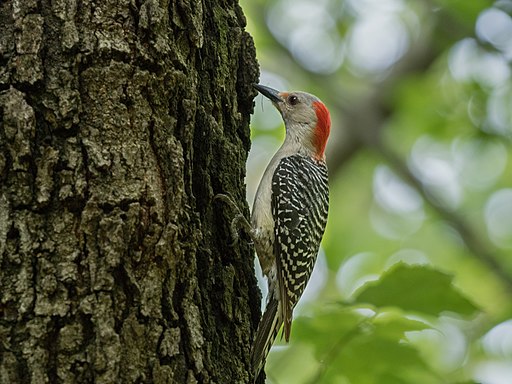Running Into Woodpeckers in Florida Species: Habitats and Habits
Running Into Woodpeckers in Florida Species: Habitats and Habits
Blog Article
Woodpeckers Unleashed: Checking Out the Marvels of These Knowledgeable Tree Mountain Climbers
Woodpeckers, with their unique markings and balanced drumming resembling with wooded locations, hold a special location in the bird globe. Their specialized makeup and adjustments allow them to navigate vertical surface areas with exceptional ability. However, their proficiency of tree climbing is just one element of their fascinating actions. As we look into the intricate information of woodpeckers' nesting routines, feeding methods, and the ongoing preservation efforts to safeguard these exceptional birds, a much deeper appreciation for their location in nature unravels.
Composition and Adaptations
When checking out the composition and adjustments of woodpeckers, one can observe amazing features that allow these birds to grow in their specialized ecological particular niche. In addition, woodpeckers have zygodactyl feet, with two toes dealing with forward and two encountering backwards, supplying a firm grasp on tree trunks while they search for food or drum for communication.
In addition, woodpeckers have a special tongue structure that is long, barbed, and sticky, allowing them to extract insects from holes in wood. This customized adaptation permits woodpeckers to make use of a food resource that is unattainable to numerous various other bird types. In general, the makeup and adaptations of woodpeckers showcase the remarkable transformative options that have enabled these birds to flourish in their arboreal environment.
Drumming Actions
Having actually explored the anatomy and adaptations of woodpeckers, the emphasis now changes to understanding their drumming habits, a distinctive facet of their communication and territorial display screens. Drumming is a vital type of interaction amongst woodpeckers, serving several purposes such as establishing regions, attracting friends, and signaling alarm system. Each woodpecker species has a special drumming pattern that aids people recognize members of their own types and differentiate them from rivals or predators.
Woodpeckers produce drumming audios by quickly pecking on powerful surfaces such as dead trees, utility poles, or perhaps metal items, producing a series of balanced beats. The strength and speed of drumming can vary based upon the purpose; as an example, a rapid drumming series may represent aggressiveness in the direction of intruders, while a slower and softer drumming pattern could show courtship (Woodpeckers in Florida). In addition, woodpeckers may change the frequency and period of their drumming to share specific messages efficiently
Nesting Practices
Discovering the nesting practices of woodpeckers reveals fascinating understandings into their reproductive actions and habitat selections. Woodpeckers are recognized for their special nesting preferences, commonly digging deep into dental caries in trees to create sheltered rooms for raising their young. These tooth cavities offer not only as a nesting site yet additionally as a protected haven from killers and severe climate.
Woodpeckers show a high degree of integrity to their nesting websites, usually going back to the same location year after year. This habits highlights the importance of ideal environment schedule for their reproductive success. The option of a nesting site is critical for woodpeckers, with aspects such get redirected here as tree species, height, and decay phase playing substantial roles in their decision-making procedure.
Remarkably, some woodpecker varieties are known to dig deep into numerous dental caries within their territory, giving themselves with alternative nesting choices. This strategy might work as a form of insurance policy against potential dangers or disturbances to their main nesting website.

Feeding Techniques
Woodpeckers employ a range of specialized feeding techniques to procure their main food resources. One of the most distinct feeding actions of woodpeckers is drumming, which entails quick pecking on trees to uncover pests beneath the bark. This drumming not just helps them find victim however also works as a method of communication with other woodpeckers. Woodpeckers have solid, chisel-like beaks that allow them to drill into wood easily. As soon as a hole is produced, they utilize their lengthy, barbed tongues to remove pests such as ants, beetles, larvae, and crawlers. helpful hints These tongues are coated with sticky saliva that helps catch the victim. Woodpeckers are additionally known to excavate dental caries in trees to gain access to surprise insect larvae or sap. Some species, like the acorn woodpecker, store nuts in particularly developed openings called granaries. This critical saving of food aids them endure throughout food deficiency periods. Woodpeckers are really exceptional in their feeding techniques, showcasing adaptability and knowledge in acquiring their nutrition.
Preservation Initiatives
Amidst the detailed feeding strategies exhibited by woodpeckers, the conservation efforts focused on securing these interesting birds play an essential duty in preserving their environments and populations. Woodpeckers face various threats to their survival, consisting of habitat loss due to logging, climate modification altering their communities, and accidents with manufactured structures such as buildings and automobiles - Woodpeckers in Florida. Conservationists are actively working to deal with these obstacles and ensure the lasting health of woodpecker species

Education and public recognition campaigns are additionally essential components of woodpecker conservation efforts. By increasing awareness regarding the relevance of try here these birds in maintaining healthy and balanced forest ecosystems, preservationists can amass assistance for habitat preservation campaigns and promote accountable land monitoring methods. With collective efforts between researchers, policymakers, and regional communities, we can interact to secure a future where woodpeckers grow in their natural environments.
Final Thought

Report this page